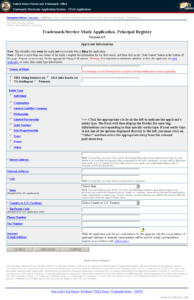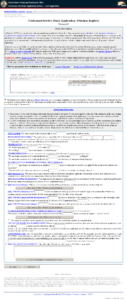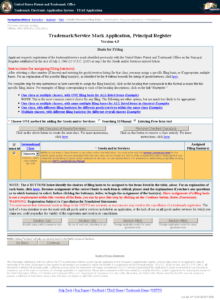File your trademark application with TEAS.

This is part three in an ongoing series about why and how to register your trademarks. Erik J. Heels is both the founder of domain name, trademark, and patent law firm Clock Tower Law Group and the owner of many trademarks and domain names.
1. Where To Start
To file a US trademark application, go to the TEAS (Trademark Electronic Application System) page and click the File NEW Application link. You will be presented with a dizzying array of choices (nice web design, USPTO), including:
- Trademark/Servicemark Application, Principal Register
- Trademark/Servicemark BLANK Application, Principal Register
- Trademark/Servicemark Application, Supplemental Register
- Certification Mark Application, Principal Register
- Collective Membership Mark Application, Principal Register
- Collective Trademark/Servicemark Application, Principal Register
- Transformation into a National Application
In 99% of the cases, you’ll want to choose the first option: applying for a new trademark in the Principal Register.
|
Principal Register vs. Supplemental Register. The USPTO has two lists (or Registers) of trademarks. The Principal Register is for marks that are distinctive. The Supplemental Register is for marks that are not (or not yet) distinctive enough. The benefits of registration in each is as follows. Registration in the Principal Register provides (among other things):
Registration in the Supplemental Register provides:
|
2. TEAS or TEAS Plus?
Next, you have to choose between the TEAS Plus Form (which costs less) and the TEAS form. TEAS Plus is, in general, a trap for the unwary and is rarely the right choice. With TEAS Plus your listing of goods/service (the stuff that you want to trademark) must come from the USPTO Acceptable Identification of Goods and Services Manual. If you choose a goods/services description that is too broad, then you run the risk of getting a likelihood-of-confusion rejection from the USPTO. Or worse, you run the risk of having a third party oppose your mark.
|
Trap For The Unwary: Drafting Trademark Applications Like Patent Applications. In my experience, overly broad goods/services descriptions are included most frequently by pro se (i.e. unrepresented) applicants and by patent attorneys who file a few trademarks “on the side.” (We’re about 50/50 patents/trademarks at my firm.) Patent attorneys are, in general, taught to draft broad claims and then narrow them during prosecution (although this practice is changing in light of Supreme Court cases such as Festo Corp. v. Shoketsu Kinzoku Kogyo Kabushiki Co., 535 U.S. 722 (2002)). If you draft trademark applications like you draft patent claims, then you are doing the legal equivalent of chest-thumping and are inviting conflict. This issue is especially important if you plan to file for foreign trademarks.
|
In addition, choosing TEAS Plus can delay your trademark from registering in certain situations. For example, you may want to narrow your goods/services listing after your trademark has been approved but before it has issued (for example, in response to a consent agreement entered into with a third-party and designed to mitigate confusion between your trademark and the third party’s trademark). Since you “saved” money by filing the TEAS Plus application (which limits what you can include in your goods/services listing), you now have to make a supplemental filing and pay an additional fee (the difference between the fees for TEAS and TEAS Plus). More filings, more time. If the application were TEAS application, you might be able to resolve the issue by calling the examiner and having him/her issue an Examiner’s Amendment.
Bottom line: don’t choose TEAS Plus. Choose TEAS.
3. Applicant Information
After a few more clicks, you’ll be ready to actually enter information into the TEAS form. Here’s what the first form looks like:
Fields marked with a red asterisk are mandatory.
|
Trap For The Unwary: Check For USPTO Errors After You File. Believe it or not, the information you enter in this form is not automatically entered into the USPTO’s pending trademark database. It is manually re-entered by USPTO employees, giving the USPTO the opportunity to misspell your name, your lawyer’s name, your address, etc. As such, we generally do not include optional information in the application, such as your phone number, fax number, and email address. (We do include our own email address.) KISS (Keep It Simple Stupid). Plus we frequently have to correct USPTO errors (such as the spelling of my name, which is “Erik” with a “k,” just like I entered it, thank you very much).
|
For the Owner of Mark section, use the company name as it appears in the Secretary of State’s corporations database for the state in which the company is organized. In this case, the owner of the RedStreet trademark is GiantPeople LLC (no comma). Commas are generally not required in company names and should be avoided (IMHO) for the inevitable confusion they will cause. So when you incorporate, do so as “Example Inc.” not “Example, Inc.” For corporations and LLCs, include the state of organization. For most other entity types, include the names and citizenships for all owners. Forgetting to include citizenship information is a common mistake.
The other sections are mostly self-explanatory. Use the USPS-approved abbreviation for your street address (e.g. “St.” for “Street”) and don’t put dots in your phone number (it’s not an IP address).
4. Mark Information
This section is relatively straightforward. You have to choose (1) what type of trademark you’re filing and (2) whether or not you need to make any additional statement.
I’ll translate the USPTO’s legalese into English. The vast majority of trademarks fall into one of two categories: words only, which the USPTO calls “Standard Characters,” or logos, which the USPTO calls “Special Form (Stylized and/or Design).” In this case, the RedStreet trademark is a word mark (“Standard Characters”). Older trademark attorneys use ALL CAPS for trademarks because that’s how trademarks used to be filed. But since there is a world of difference between PenIsland (pen store) and PenisLand (something else), I prefer to present the trademarks how they are used: same use of spaces, same use of case.
|
Trap For The Unwary: Logos vs. Words. If you have a distinctive logo that contains words, then you should eventually file both word and logo marks because they protect different things: the word mark the word itself, the logo the look-and-feel of the logo. For example, I have CLOCK TOWER LAW GROUP as a word logo and also have my airplane logo trademarked, since I want to stop any other law firm from having “Clock Tower” in its name or a retro 1950s-style airplane in its logo. Sometimes, the descriptive parts of a trademark have to be “disclaimed” as part of a trademark application. So “Bob’s Grocery Store” would not be trademarkable because it is descriptive, but a distinctive logo for Bob’s Grocery Store might be. This is the cool part about logo trademarks. When people search the USPTO’s trademark database for “Bob’s Grocery Store,” they will find the logo trademark, so it will discourage them from trying to register similar trademarks. If a mark is primarily descriptive, then we recommend leading with the logo application and then following up in a year with the word application (the logo application blazing the trail for the word application). If the mark is fanciful or arbitrary, then we recommend leading with the word mark, which will give the broadest protection as soon as possible.
|
For the additional statement section, simply check the appropriate statement(s) and fill in the requested info. Don’t worry if you don’t know what to include. If you omit something that you should have included, then the USPTO will initially reject your trademark application (by issuing an “office action”) and will give you six months (in most cases) to fix the problem. If your problem can’t be remedied by an office action response, then you can always refile your trademark application. Of course, you will lose the original filing date and will have to pay another filing fee when you refile.
The additional statement options are as follows (fill in the BLANKs):
- DISCLAIMER: “No claim is made to the exclusive right to use BLANK apart from the mark as shown.”
- PRIOR REGISTRATION(S): ” The applicant claims ownership of U.S. Registration Number(s) BLANK, BLANK, BLANK.” (Required if warranted by facts of application.) NOTE: Entry must not include any commas, and must be 7 numerals long (if necessary, add leading 0’s to number, e.g., 0086417).
- TRANSLATION: (Required if warranted by facts of application.) “The English translation of in the mark is BLANK.” OR: “The wording BLANK has no meaning in a foreign language.”
- TRANSLITERATION: (Required if warranted by facts of application. NOTE: Not required for any standard character marks.) “The non-Latin characters in the mark transliterate to BLANK and this means BLANK in English.” OR: “The non-Latin characters in the mark transliterate to BLANK and this has no meaning in a foreign language.”
- SIGNIFICANCE OF WORDING, LETTER(S), OR NUMERAL(S): “BLANK appearing in the mark means or signifies in the relevant trade or industry or as applied to the goods/services listed in the application.” OR: “The non-Latin characters in the mark transliterate to BLANK and this has no meaning in a foreign language.”
- §2(f), based on Use: “The mark has become distinctive of the goods/services through the applicant’s substantially exclusive and continuous use in commerce for at least the five years immediately before the date of this statement.”
- §2(f), based on Prior Registration(s): “The mark has become distinctive of the goods/services as evidenced by the ownership on the Principal Register for the same mark for related goods or services of U.S. Registration No(s). BLANK.”
- §2(f), based on Evidence: “The mark has become distinctive of the goods/services, as demonstrated by the attached evidence.”
- §2(f), IN PART, based on Use: “BLANK has become distinctive of the goods/services through the applicant’s substantially exclusive and continuous use in commerce for at least the five years immediately before the date of this statement.”
- §2(f), IN PART, based on Prior Registration(s): “BLANK has become distinctive of the goods/services as evidenced by the ownership on the Principal Register for the same mark for related goods or services of U.S. Registration No(s). BLANK.”
- §2(f), IN PART, based on Evidence: ” has become distinctive of the goods/services, as demonstrated by the attached evidence.”
- “The name(s), portrait(s), and/or signature(s) shown in the mark does not identify a particular living individual.”
- USE OF THE MARK IN ANOTHER FORM: “The mark was first used anywhere in a different form other than that sought to be registered at least as early as BLANK, and in commerce at least as early as BLANK.” NOTE: If the use in another form claim does not relate to all classes in a multi-class application, specify within the miscellaneous statement section, below, the exact class(es) the claim covers.
- CONCURRENT USE: Enter the appropriate concurrent use information, e.g., specify the goods and the geographic area for which registration is sought. WARNING: Enter text in the box only if you (1) intend to initiate a concurrent use registration proceeding before the Trademark Trial and Appeal Board; or (2) have a final determination by a court establishing your concurrent right to use the same or similar mark in commerce in a limited geographic area. BLANK (Required if warranted by facts of application.)
- MISCELLANEOUS STATEMENT: Enter information for which no other section of the form is appropriate. BLANK
“The name(s), portrait(s), and/or signature(s) shown in the mark identifies BLANK, whose consent(s) to register is made of record.”
Two of the most common additional statements are (1) consent of a named/pictured individual and (2) disclaimers of descriptive terms. For example, even though Barack Obama campaigned for change, you still can’t trademark his name or image without his permission. Regarding disclaimers, if your trademark is ACME BOOK STORE, then you should disclaim the descriptive “BOOK STORE” portion. See also my CLOCK TOWER LAW GROUP example above.
By far the biggest problem we see with trademark application is poor trademark selection. At this point, you might want to review the choosing a good name article.
|
Descriptiveness – The “Microsoft Windows” Approach. If your trademark is at least partially descriptive, then consider adding your (hopefully trademarked) company name to the trademark. When you have one strong registered trademark and are trying to register a second weaker (e.g. because it may arguably be descriptive) trademark, it makes sense to consider the “Microsoft Windows” approach: (1) First, register the strong trademark (Microsoft®). This is a longer-term strategy that can be used to broaden your trademark rights and secure federal registration for trademarks that may not have been able to stand on their own initially.
|
For the RedStreet trademark application, the mark was a word mark, and no additional statement was required.
5. Goods/Services and Filing Basis
It’s best to use a customized goods/services listing rather than one from the USPTO Acceptable Identification of Goods and Services Manual. But use the manual as a guide.
You should select the “Entering Free-form text” option and click the “Add Class(es) of Goods/Services” button.
When selecting the International Class for your goods/service statement, you should ask yourself a couple of questions:
- What do you sell, to whom, and how?
- What is your cattle? In other words, what do you put your brand on?
It’s really easy to get the international class part wrong. For example, a shoe manufacturer such as Mephisto makes shoes, and the Mephisto trademark is in class 25. Zapppos, on the other hand, is a shoe retailer, and the Zappos trademark is in class 35. Both sell shoes, but one is a wholesaler, the other a retailer. They belong in different classes.
|
Classes Are Like Domain Names. You can have more than one. For example, desktop software is generally in class 9, but software as a service (SaaS) is generally in class 42. Your trademark can likely be classified in more than one class. If your company name is Example Inc., then your domain names might be:
And your trademarks, in domain-name-like syntax, might be:
Likelihood of confusion occurs between two trademarks when the parts to the left and right of the first dot are too close. At least that’s how I think about it.
|
The filing basis part is easier. Your choices are:
- Section 1(a) – Actually using mark in commerce now
- Section 1(b) – No use of mark yet, intending to use
- Section 44(d) – Foreign application exists for same goods/services
- Section 44(e) – Foreign registration exists for same goods/services
For US applications, you should choose either 1(a) (use-based) or 1(b) (intent-to-use, also called ITU). ITU applications generally end up costing more, because there are two filings: the initial filing followed by a second filing (a specimen with a Statement of Use) demonstrating proper trademark use. In general, if you are already using your trademark properly, then you should file a use-based application.
The RedStreet trademark is clearly in use, but what are the goods/services? RedStreet the company used to provide Internet consulting services to law firms. But RedStreet the website is now an archive of law firm website reviews provided by GiantPeople LLC. Here’s the goods/services as filed for the RedStreet trademark application:
Providing a website featuring reviews of other websites, particularly websites which provide legal services (in international class 042)
6. Specimen
For use-based applications, after you’ve chosen your international class, goods/service description, and filing basis, you’ll need to upload your specimen and specify the use dates.
|
Date Of First Use Of Mark Anywhere. The date on which the goods were first sold or transported or the services first rendered under the mark if such use was in the ordinary course of trade. For every applicant, whether foreign or domestic, the date of first use of a mark is the date of the first such use anywhere, in the United States or elsewhere. Please note this date may be earlier than, or the same as, the date of the first use of the mark in commerce. Date Of First Use Of Mark In Commerce. The date on which the owner first used the mark in commerce, i.e., in interstate commerce, territorial commerce, or commerce between the U.S. and a foreign country.
|
A “specimen” is an example of the mark being used in commerce as a trademark. In order for something to serve as a trademark, it needs to be a source-identifier for the specified goods/services. This typically means that the trademark should be prominent and should stand out from non-trademarked terms. Each trademark specimen needs to show:
- the trademark,
- being used as a trademark,
- on the goods (or, in the case of services, near the description of the services),
- that are described in the trademark application.
For goods (including software), acceptable specimens include product labels, tags, containers, displays, instruction manuals, and photos of the mark as actually used on or in connection with the goods.
For downloadable software goods, an acceptable specimen may be a screen shot of the mark as actually used in the software.
For services, acceptable specimens include newspaper and magazine advertisements, brochures, billboards, handbills, direct-mail leaflets, menus, website screenshots, and the like. Since websites are inherently interstate and inherently relate to commerce, a good specimen would be a screen shot of a page from your website showing the mark being used as a trademark.
For the RedStreet trademark application, we used various screenshots of the RedStreet website for the specimen.
7. Attorney Information and Signature
The final two sections are attorney information (self explanatory) and signature. The “signature” is something of your choosing enclosed in slashes, such as /JohnQPublic/.
|
Trap For The Unwary: False Statements Could Be Construed As Fraud. Pay attention to the declaration when you sign the application, which says: “The undersigned, being hereby warned that willful false statements and the like so made are punishable by fine or imprisonment, or both, under 18 U.S.C. §1001, and that such willful false statements may jeopardize the validity of the form or any resulting registration, declares that he/she is properly authorized to execute this form on behalf of the applicant; he/she believes the applicant to be the owner of the trademark/service mark sought to be registered, or, if the form is being filed under 15 U.S.C. §1126(d) or (e), he/she believes applicant to be entitled to use such mark in commerce; to the best of his/her knowledge and belief no other person, firm, corporation, or association has the right to use the mark in commerce, either in the identical form thereof or in such near resemblance thereto as to be likely, when used on or in connection with the goods/services of such other person, to cause confusion, or to cause mistake, or to deceive; and that all statements made of his/her own knowledge are true; and that all statements made on information and belief are believed to be true.”
|
Validate your application, pay the filing fees, submit the application, and save your receipt. A new feature lets you save a PDF version of your application.
8. Next Steps
- Junk Mail. Since your company name is (or soon will be) in public files at the USPTO, you may receive offers from various vendors for trademark-related services. Some of these vendors make their mail look like official government mail, so be alert for possible scams.
- Examination. If the USPTO determines that the application meets all filing requirements, then the application will be processed, and in approximately eight months, you will hear from the assigned examining attorney. The examining attorney may ask for more information or may reject the trademark application, and you will have an opportunity to respond to any of the examiner’s questions.
- Use Statements. For Intent-To-Use applications, an applicant may file an Amendment to Allege Use any time between the filing date of the application and the date the Examining Attorney approves the mark for publication. If an Amendment to Allege Use is not filed, then the applicant has six months from the issuance of the Notice of Allowance to file a Statement of Use, unless the applicant requests and is granted an extension of time. The deadline can be extended up to 36 months.
- Certificate Of Registration. It is difficult to say exactly how long it takes from the filing of your application to the receipt of a final Certificate of Registration, because numerous issues can arise during the examination process that can lengthen the process. However, if there are no substantive or procedural problems and no third party files a Notice of Opposition, then it may be possible to obtain a Certificate of Registration within 11-13 months from the application’s filing date.
9. Summary
It is possible to file your own trademark application, but it is also extremely easy to make mistakes. And not all mistakes can be remedied. The purpose of this series is not to give legal advice but rather to semi-live blog the RedStreet trademark application and discuss the issues as they arise. An ounce of prevention is much less expensive than a pound of cure, but, FWIW, my law firm makes more money fixing applications filed pro se than we do from filing trademark applications from scratch.
Related Posts
- How To Register A Trademark: Part 2: Trademark Search
Search trademarks to rule out likelihood of confusion. - How To Register A Trademark: Part 1: Choosing A Good Name
A trademark is to your business as a foundation is to your house. - FreeTrademarksForStartups.com: Free Trademarks For Startups
The best time for entrepreneurs to start a new business is during a recession. - Madrid Protocol: Affordable International Trademarks For Startups
The Madrid Protocol is a great option for startups who want foreign trademark protection but don’t want to file trademarks in separate countries. - Domain Name Law
White hat domainers are not black hat cybersquatters. - Trademarks For Slogans And Taglines
Trademarking slogans and taglines. - Trademarks For Product And Service Names
Trademarking product and service names. - Trademarks For Logos
Trademarking logos. - Trademarks For Company Names And Nicknames
Trademarking company names and nicknames. Just drop the “Inc.” - Just Say Moo – How To Name And Brand Your Product To Make It Stand Out From The Crowd
Good branding can separate your cow from the other cattle.






* How To Register A Trademark: Part 1: Choosing A Good Name (2009-02-11)
A trademark is to your business as a foundation is to your house.
https://www.giantpeople.com/1366.html
* How To Register A Trademark: Part 2: Trademark Search (2009-03-11)
Search trademarks to rule out likelihood of confusion.
https://www.giantpeople.com/1448.html
* How To Register A Trademark: Part 3: Trademark Filing (2009-04-07)
File your trademark application with TEAS.
https://www.giantpeople.com/1594.html
Rich, thanks for reading and noticing that typo. The typo has been fixed!
Typo: ‘patents’ replace with ‘trademarks’ in:
“This issue is especially important if you plan to file for foreign patents.”
Greetings Mandy,
Good questions, but please email me at info@clocktowerlaw.com to discuss. Thanks.
Regards,
Erik
Erik, thanks for this incredibly helpful post. Question: If I register my domain name, AngloFiles, as a trademark, will that also cover my blog of the same name (and linked to that URL)? Or do I need separate TMs?
On TESS, I was able to find Class 41 (“online journals, namely, blogs featuring …” ) but not a specific class for domain names.
Great Post!
Wow! What a process 😀